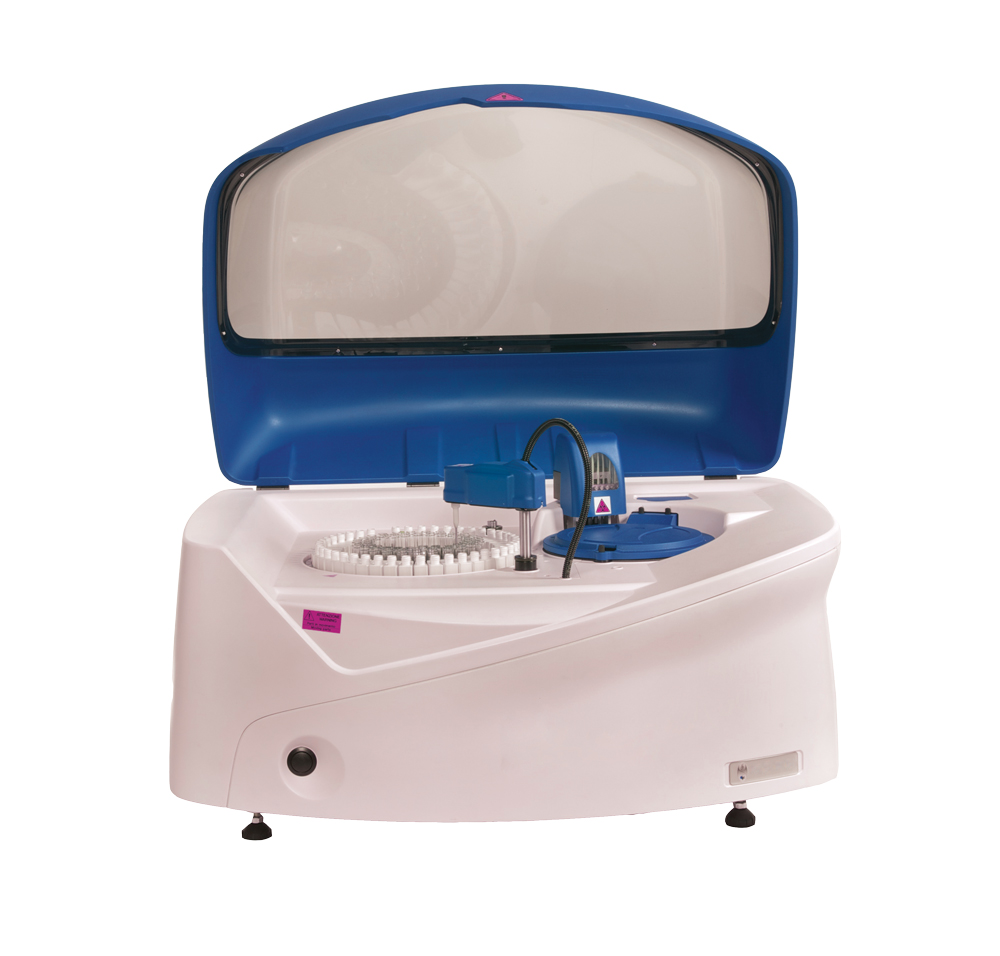Clinical Chemistry Instruments and Reagents Under Scrutiny at the 2015 AACC Annual Meeting
|
By LabMedica International staff writers Posted on 27 Jul 2015 |

Image: The Altair 240 clinical chemistry analyzer (Photo courtesy of EKF Diagnostics).

Image: The Stanbio Chemistry GSP LiquiColor Assay analyzer (Photo courtesy of EKF Diagnostics).
Clinical chemistry, both instrumentation and reagents, was the focus of presentations at booth 1018 at the 2015 AACC Annual Meeting & Clinical Lab Expo (Atlanta, GA, USA).
EKF Diagnostics (Cardiff, United Kingdom), a global in vitro diagnostics company, took advantage of the AACC Annual Meeting to launch the Altair 240 clinical chemistry analyzer.
This new bench-top platform represents EKF Diagnostics’ first fully integrated chemistry system designed for the global market. EKF believes that the new Altair 240 clinical chemistry analyzer fulfills an international market need for a fully automated bench-top platform supported by the reliable Stanbio Chemistry (Boerne, TX, USA) reagent menu.
“We listened to the needs of our customers and designed the Altair 240 to be easy to learn, operate, and maintain,” said Albert Blanco, business unit director at EKF Diagnostics. “Because it runs on Windows 7, operators can easily navigate its intuitive, touch screen menu. Features such as the capability to use bar coded, primary sample tubes, auto-rerun, auto-dilution and STAT interruption—all function to maximize the system’s overall efficiency.”
EKF will also use the AACC Annual Meeting venue to discuss the latest additions to its Stanbio clinical chemistry range. This range includes a large selection of clinical chemistry assays, controls, and calibrators, which are fully compatible with most major brand open channel chemistry analyzers.
A notable addition to the reagent menu is the Stanbio Chemistry Glycated Serum Protein (GSP) LiquiColor test; a new diabetes biomarker test that provides a two to three week indicator of average blood glucose. The GSP LiquiColor test is based on a double enzymatic degradation method that utilizes the specificity of fructosyl-amino oxidase to eliminate inaccuracies caused by non-glycated protein reducing substances, which significantly interfere with the NBT fructosamine method. The test is available as a liquid-stable kit with calibrator. It is suitable for use on a variety of clinical chemistry analyzers, with on-board stability of up to four weeks.
Other instruments to be highlighted at the AACC Annual Meeting include the DiaSpect and HemoPoint H2. DiaSpect is a hand held device touted as being the world’s fastest hemoglobin measurement system. The instrument is described as offering laboratory quality performance for anemia screening in all climatic conditions in less than two seconds. The HemoPoint H2 stores over 4000 patient results and is designed for use in blood banks, clinics, and hospitals. This instrument provides immediate and simultaneous high quality results for both hemoglobin and hematocrit.
Related Links:
2015 AACC Annual Meeting & Clinical Lab Expo
EKF Diagnostics
Stanbio Chemistry
EKF Diagnostics (Cardiff, United Kingdom), a global in vitro diagnostics company, took advantage of the AACC Annual Meeting to launch the Altair 240 clinical chemistry analyzer.
This new bench-top platform represents EKF Diagnostics’ first fully integrated chemistry system designed for the global market. EKF believes that the new Altair 240 clinical chemistry analyzer fulfills an international market need for a fully automated bench-top platform supported by the reliable Stanbio Chemistry (Boerne, TX, USA) reagent menu.
“We listened to the needs of our customers and designed the Altair 240 to be easy to learn, operate, and maintain,” said Albert Blanco, business unit director at EKF Diagnostics. “Because it runs on Windows 7, operators can easily navigate its intuitive, touch screen menu. Features such as the capability to use bar coded, primary sample tubes, auto-rerun, auto-dilution and STAT interruption—all function to maximize the system’s overall efficiency.”
EKF will also use the AACC Annual Meeting venue to discuss the latest additions to its Stanbio clinical chemistry range. This range includes a large selection of clinical chemistry assays, controls, and calibrators, which are fully compatible with most major brand open channel chemistry analyzers.
A notable addition to the reagent menu is the Stanbio Chemistry Glycated Serum Protein (GSP) LiquiColor test; a new diabetes biomarker test that provides a two to three week indicator of average blood glucose. The GSP LiquiColor test is based on a double enzymatic degradation method that utilizes the specificity of fructosyl-amino oxidase to eliminate inaccuracies caused by non-glycated protein reducing substances, which significantly interfere with the NBT fructosamine method. The test is available as a liquid-stable kit with calibrator. It is suitable for use on a variety of clinical chemistry analyzers, with on-board stability of up to four weeks.
Other instruments to be highlighted at the AACC Annual Meeting include the DiaSpect and HemoPoint H2. DiaSpect is a hand held device touted as being the world’s fastest hemoglobin measurement system. The instrument is described as offering laboratory quality performance for anemia screening in all climatic conditions in less than two seconds. The HemoPoint H2 stores over 4000 patient results and is designed for use in blood banks, clinics, and hospitals. This instrument provides immediate and simultaneous high quality results for both hemoglobin and hematocrit.
Related Links:
2015 AACC Annual Meeting & Clinical Lab Expo
EKF Diagnostics
Stanbio Chemistry
Latest AACC 2015 News
- Automated Molecular Diagnostics System Presented at AACC 2015
- Portable Molecular Diagnostics System Unveiled At 2015 AACC
- Expanded Steroid Control Launched at the 2015 AACC Annual Meeting
- Innovative New Technology to Provide Plastic-Exterior Components with Glass Interior, Presented at AACC 2015
- Eco-Friendly Immunoassay Reagents Featured at AACC 2015
- Low Cost Point-of-Care DNA Amplification Test for Chlamydia Infection Demonstrated at the 2015 AACC Annual Meeting
- Inexpensive Multipurpose Point-of-Care Analyzer Unveiled at 2015 AACC Annual Meeting
- State-of-the-Art Automated Laboratory Systems Highlighted at the 2015 AACC Annual Meeting
- Siemens Showcases Multiple New IVD Solutions at AACC 2015
- New HPLC Quadruples Clinical Throughput Capabilities, Displayed at AACC 2015
- Diagnostic Test that Measures Active Renin in Hypertension Displayed at the 2015 AACC Annual Meeting
- Hair Testing May Offer Insights into Asthma-Related Complications in Pregnancy
- Two Newly Developed Tests May Better Diabetes Diagnosis and Monitoring
- CE Marking of Theranostic Monitoring Test Announced at 2015 AACC Annual Meeting
- Ebola Rapid Lateral Flow Test Previewed at the 2015 AACC Annual Meeting
- AACC: Better Quality and Patient-Friendliness Needed in Direct Testing
Channels
Clinical Chemistry
view channel
‘Brilliantly Luminous’ Nanoscale Chemical Tool to Improve Disease Detection
Thousands of commercially available glowing molecules known as fluorophores are commonly used in medical imaging, disease detection, biomarker tagging, and chemical analysis. They are also integral in... Read more
Low-Cost Portable Screening Test to Transform Kidney Disease Detection
Millions of individuals suffer from kidney disease, which often remains undiagnosed until it has reached a critical stage. This silent epidemic not only diminishes the quality of life for those affected... Read more
New Method Uses Pulsed Infrared Light to Find Cancer's 'Fingerprints' In Blood Plasma
Cancer diagnoses have traditionally relied on invasive or time-consuming procedures like tissue biopsies. Now, new research published in ACS Central Science introduces a method that utilizes pulsed infrared... Read moreMolecular Diagnostics
view channel
New Genetic Tool Analyzes Umbilical Cord Blood to Predict Future Disease
Children are experiencing metabolic problems at increasingly younger ages, placing them at higher risk for serious health issues later in life. There is a growing need to identify this risk from birth... Read more
Spinal Fluid Biomarker for Parkinson’s Disease Offers Early and Accurate Diagnosis
Parkinson’s disease is a neurodegenerative condition typically diagnosed at an advanced stage based on clinical symptoms, primarily motor disorders. However, by this time, the brain has already undergone... Read moreHematology
view channel
New Scoring System Predicts Risk of Developing Cancer from Common Blood Disorder
Clonal cytopenia of undetermined significance (CCUS) is a blood disorder commonly found in older adults, characterized by mutations in blood cells and a low blood count, but without any obvious cause or... Read more
Non-Invasive Prenatal Test for Fetal RhD Status Demonstrates 100% Accuracy
In the United States, approximately 15% of pregnant individuals are RhD-negative. However, in about 40% of these cases, the fetus is also RhD-negative, making the administration of RhoGAM unnecessary.... Read moreImmunology
view channel
Stem Cell Test Predicts Treatment Outcome for Patients with Platinum-Resistant Ovarian Cancer
Epithelial ovarian cancer frequently responds to chemotherapy initially, but eventually, the tumor develops resistance to the therapy, leading to regrowth. This resistance is partially due to the activation... Read more
Machine Learning-Enabled Blood Test Predicts Immunotherapy Response in Lymphoma Patients
Chimeric antigen receptor (CAR) T-cell therapy has emerged as one of the most promising recent developments in the treatment of blood cancers. However, over half of non-Hodgkin lymphoma (NHL) patients... Read moreMicrobiology
view channel
Handheld Device Delivers Low-Cost TB Results in Less Than One Hour
Tuberculosis (TB) remains the deadliest infectious disease globally, affecting an estimated 10 million people annually. In 2021, about 4.2 million TB cases went undiagnosed or unreported, mainly due to... Read more
New AI-Based Method Improves Diagnosis of Drug-Resistant Infections
Drug-resistant infections, particularly those caused by deadly bacteria like tuberculosis and staphylococcus, are rapidly emerging as a global health emergency. These infections are more difficult to treat,... Read more
Breakthrough Diagnostic Technology Identifies Bacterial Infections with Almost 100% Accuracy within Three Hours
Rapid and precise identification of pathogenic microbes in patient samples is essential for the effective treatment of acute infectious diseases, such as sepsis. The fluorescence in situ hybridization... Read morePathology
view channel
Sensitive and Specific DUB Enzyme Assay Kits Require Minimal Setup Without Substrate Preparation
Ubiquitination and deubiquitination are two important physiological processes in the ubiquitin-proteasome system, responsible for protein degradation in cells. Deubiquitinating (DUB) enzymes contain around... Read more
World’s First AI Model for Thyroid Cancer Diagnosis Achieves Over 90% Accuracy
Thyroid cancer is one of the most common cancers worldwide, and its precise management typically relies on two primary systems: (1) the 8th edition of the American Joint Committee on Cancer (AJCC) or ... Read more
Breakthrough Diagnostic Approach to Significantly Improve TB Detection
Tuberculosis (TB) remains the deadliest infectious disease globally, with 10.8 million new cases and 1.25 million deaths reported in 2023. Early detection through effective screening is crucial in identifying... Read more
Rapid, Ultra-Sensitive, PCR-Free Detection Method Makes Genetic Analysis More Accessible
Genetic testing has been an important method for detecting infectious diseases, diagnosing early-stage cancer, ensuring food safety, and analyzing environmental DNA. For a long time, polymerase chain reaction... Read moreTechnology
view channel
Disposable Microchip Technology Could Selectively Detect HIV in Whole Blood Samples
As of the end of 2023, approximately 40 million people globally were living with HIV, and around 630,000 individuals died from AIDS-related illnesses that same year. Despite a substantial decline in deaths... Read more
Pain-On-A-Chip Microfluidic Device Determines Types of Chronic Pain from Blood Samples
Chronic pain is a widespread condition that remains difficult to manage, and existing clinical methods for its treatment rely largely on self-reporting, which can be subjective and especially problematic... Read more
Innovative, Label-Free Ratiometric Fluorosensor Enables More Sensitive Viral RNA Detection
Viruses present a major global health risk, as demonstrated by recent pandemics, making early detection and identification essential for preventing new outbreaks. While traditional detection methods are... Read moreIndustry
view channel
Cepheid and Oxford Nanopore Technologies Partner on Advancing Automated Sequencing-Based Solutions
Cepheid (Sunnyvale, CA, USA), a leading molecular diagnostics company, and Oxford Nanopore Technologies (Oxford, UK), the company behind a new generation of sequencing-based molecular analysis technologies,... Read more
Grifols and Tecan’s IBL Collaborate on Advanced Biomarker Panels
Grifols (Barcelona, Spain), one of the world’s leading producers of plasma-derived medicines and innovative diagnostic solutions, is expanding its offer in clinical diagnostics through a strategic partnership... Read more








 Assay.jpg)













